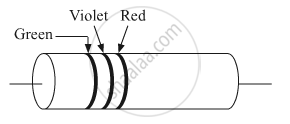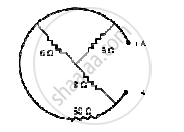Advertisements
Advertisements
Question
An electrolysis experiment is stopped and the battery terminals are reversed.
Options
The electrolysis will stop
The rate of liberation of material at the electrodes will increase
The rate of liberation of material will remain the same
Heat will be produced at a greater rate
Solution
The rate of liberation of material will remain the same
In an electrolytic cell, both the electrodes are made of the same material. Thus, on reversing the terminals of the battery, the direction of the flow of charges will be reversed, but the rate of the electrolysis will remain the same.
APPEARS IN
RELATED QUESTIONS
Define the term 'conductivity' of a metallic wire. Write its SI unit.
Using the concept of free electrons in a conductor, derive the expression for the conductivity of a wire in terms of number density and relaxation time. Hence obtain the relation between current density and the applied electric field E.
Define current density. Write an expression which connects current density with drift speed
The following figure shows a conductor of length l with a circular cross-section. The radius of the cross-section varies linearly from a to b. The resistivity of the material is ρ. Assuming that b – a << l, find the resistance of the conductor.

A heater coil is to be constructed with a nichrome wire (ρ = 1.0 × 10−6 Ωm) that can operate at 500 W when connected to a 250 V supply. (a) What would be the resistance of the coil? (b) If the cross-sectional area of the wire is 0.5 mm2, what length of the wire will be needed? (c) If the radius of each turn is 4.0 mm, how many turns will be there in the coil?
A carbon resistor is shown in the figure. Using color code, write the value of the resistance.

Fill in the blank.
The ___________, a property of materials C, Si, and Ge depends upon the energy gap between their conduction and valence bands.
Consider a current carrying wire (current I) in the shape of a circle.
The electric resistance of a certain wire of iron is R. If its length and radius are both doubled, then ______.
A constant voltage is applied between the two ends of a uniform metallic wire, heat ‘H’ is developed in it. If another wire of the same material, double the radius and twice the length as compared to the original wire is used then the heat developed in it will be -
The equivalent resistance between A and B is ____________.

A man covers his body with a blanket of thickness 4 mm. His temperature is 37°C and that of the atmosphere is 27°C. If the coefficient of thermal conductivity of wool is 1.2 × 10-5 MKS units, heat lost by him per hour per square meter area is:
As the temperature of conductor increase, it's resistivity and conductivity change. The ratio of resistivity to conductivity.
The resistivity of a wire ______
Consider four conducting materials copper, tungsten, mercury and aluminium with resistivity ρC, ρT, ρM and ρA respectively. Then:
